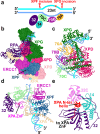Molecular architecture and functional dynamics of the pre-incision complex in nucleotide excision repair
- PMID: 39353945
- PMCID: PMC11445577
- DOI: 10.1038/s41467-024-52860-y
Molecular architecture and functional dynamics of the pre-incision complex in nucleotide excision repair
Abstract
Nucleotide excision repair (NER) is vital for genome integrity. Yet, our understanding of the complex NER protein machinery remains incomplete. Combining cryo-EM and XL-MS data with AlphaFold2 predictions, we build an integrative model of the NER pre-incision complex(PInC). Here TFIIH serves as a molecular ruler, defining the DNA bubble size and precisely positioning the XPG and XPF nucleases for incision. Using simulations and graph theoretical analyses, we unveil PInC's assembly, global motions, and partitioning into dynamic communities. Remarkably, XPG caps XPD's DNA-binding groove and bridges both junctions of the DNA bubble, suggesting a novel coordination mechanism of PInC's dual incision. XPA rigging interlaces XPF/ERCC1 with RPA, XPD, XPB, and 5' ssDNA, exposing XPA's crucial role in licensing the XPF/ERCC1 incision. Mapping disease mutations onto our models reveals clustering into distinct mechanistic classes, elucidating xeroderma pigmentosum and Cockayne syndrome disease etiology.
© 2024. The Author(s).
Conflict of interest statement
The authors declare no competing interests.
Figures








References
-
- Brueckner, F., Hennecke, U., Carell, T. & Cramer, P. CPD damage recognition by transcribing RNA polymerase II. Science315, 859–862 (2007). - PubMed
-
- Marteijn, J. A., Lans, H., Vermeulen, W. & Hoeijmakers, J. H. Understanding nucleotide excision repair and its roles in cancer and ageing. Nat. Rev. Mol. Cell Biol.15, 465–481 (2014). - PubMed
Publication types
MeSH terms
Substances
Associated data
- Actions
- Actions
- Actions
- Actions
- Actions
- Actions
- Actions
- Actions
- Actions
- Actions
- Actions
- Actions
- Actions
- Actions
Grants and funding
- 2027902/NSF | BIO | Division of Molecular and Cellular Biosciences (MCB)
- R35 GM139382/GM/NIGMS NIH HHS/United States
- R35GM139382/U.S. Department of Health & Human Services | NIH | National Institute of General Medical Sciences (NIGMS)
- P01 CA092584/CA/NCI NIH HHS/United States
- ES032786/U.S. Department of Health & Human Services | NIH | National Institute of Environmental Health Sciences (NIEHS)
LinkOut - more resources
Full Text Sources
Research Materials
Miscellaneous

